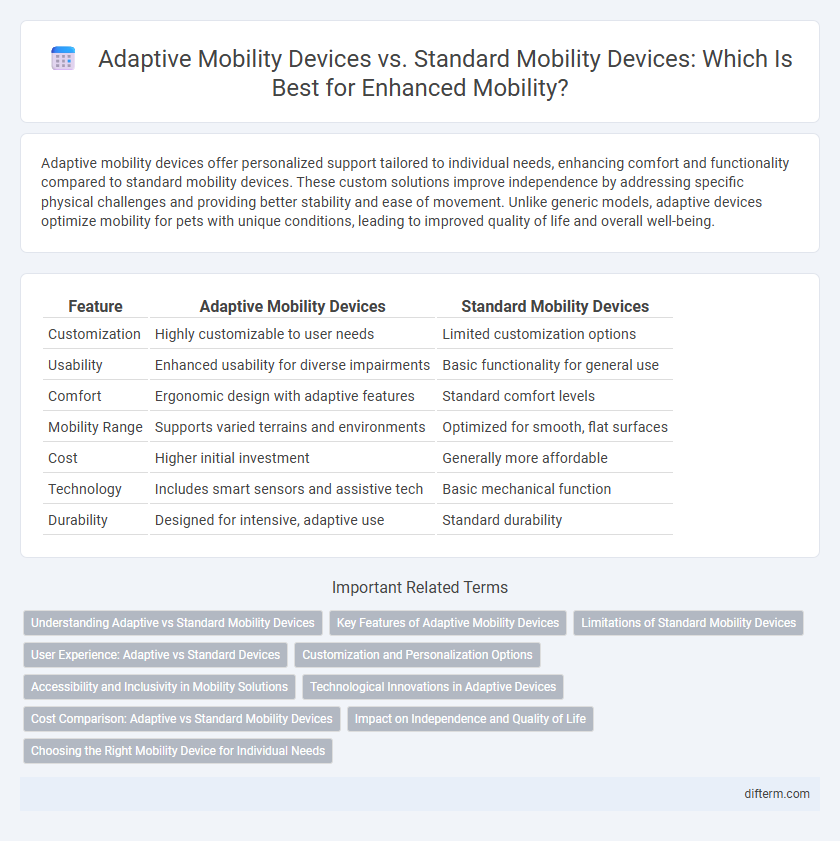Adaptive mobility devices offer personalized support tailored to individual needs, enhancing comfort and functionality compared to standard mobility devices. These custom solutions improve independence by addressing specific physical challenges and providing better stability and ease of movement. Unlike generic models, adaptive devices optimize mobility for pets with unique conditions, leading to improved quality of life and overall well-being.
Table of Comparison
| Feature | Adaptive Mobility Devices | Standard Mobility Devices |
|---|---|---|
| Customization | Highly customizable to user needs | Limited customization options |
| Usability | Enhanced usability for diverse impairments | Basic functionality for general use |
| Comfort | Ergonomic design with adaptive features | Standard comfort levels |
| Mobility Range | Supports varied terrains and environments | Optimized for smooth, flat surfaces |
| Cost | Higher initial investment | Generally more affordable |
| Technology | Includes smart sensors and assistive tech | Basic mechanical function |
| Durability | Designed for intensive, adaptive use | Standard durability |
Understanding Adaptive vs Standard Mobility Devices
Adaptive mobility devices are customized to meet individual user needs, incorporating features like adjustable supports, sensor technology, and tailored ergonomics to enhance comfort and functionality. Standard mobility devices typically offer generic designs intended for broader populations without personalized modifications, often leading to less optimal user experience. Understanding the key differences in adaptability, user support, and technological integration helps in selecting the appropriate mobility aid for improved independence and mobility outcomes.
Key Features of Adaptive Mobility Devices
Adaptive mobility devices offer customizable support through adjustable components designed for user-specific ergonomic needs, enhancing comfort and functionality. These devices often integrate advanced technology such as pressure sensors and electronic controls to improve safety and ease of use. Compared to standard mobility devices, adaptive options provide superior adaptability, promoting better posture, increased independence, and personalized mobility solutions.
Limitations of Standard Mobility Devices
Standard mobility devices often lack customization options, resulting in limited comfort and inadequate support for users with diverse physical needs. Their rigid design can contribute to increased risk of pressure sores, pain, and reduced mobility efficiency during prolonged use. These limitations highlight the growing demand for adaptive mobility devices that offer personalized adjustments and enhanced user experience.
User Experience: Adaptive vs Standard Devices
Adaptive mobility devices enhance user experience by offering personalized adjustments that cater to individual needs, improving comfort and functionality compared to standard devices. These devices often incorporate advanced technologies such as pressure mapping, ergonomic design, and customizable control systems, resulting in greater independence and reduced risk of injury. Users report higher satisfaction and increased mobility confidence when utilizing adaptive devices tailored to their specific physical requirements.
Customization and Personalization Options
Adaptive mobility devices offer enhanced customization and personalization options compared to standard mobility devices, allowing users to adjust features such as seating, controls, and support to meet individual physical needs and preferences. Customizable components like adjustable seat height, specialized cushions, and tailored control interfaces improve comfort, functionality, and overall user experience. Personalized mobility solutions increase independence and reduce the risk of secondary injuries by accommodating unique mobility challenges and lifestyle requirements.
Accessibility and Inclusivity in Mobility Solutions
Adaptive mobility devices enhance accessibility by tailoring support to individual needs, addressing diverse physical abilities more effectively than standard devices. These solutions promote inclusivity by enabling users with varying mobility challenges to participate fully in daily activities and social environments. Integration of customizable features and ergonomic designs in adaptive devices supports a broader range of users, fostering independence and equal opportunity.
Technological Innovations in Adaptive Devices
Technological innovations in adaptive mobility devices incorporate advanced sensors, AI-driven customization, and smart materials to enhance user comfort and functionality compared to standard mobility devices. Features like real-time gait analysis, automatic terrain adjustment, and personalized support systems improve independence and safety for users with diverse mobility needs. These cutting-edge developments significantly elevate the performance and adaptability of mobility aids beyond traditional designs.
Cost Comparison: Adaptive vs Standard Mobility Devices
Adaptive mobility devices generally have higher upfront costs than standard mobility devices due to customization and specialized features tailored to individual needs. While standard mobility devices offer affordability and mass-market availability, adaptive devices may reduce long-term expenses by enhancing user independence and decreasing the need for additional caregiving or medical interventions. Evaluating total cost of ownership, including maintenance, durability, and health-related savings, is crucial when comparing adaptive versus standard mobility solutions.
Impact on Independence and Quality of Life
Adaptive mobility devices enhance independence by offering personalized support tailored to individual needs, significantly improving users' ability to navigate diverse environments. These devices promote greater autonomy, reducing reliance on caregivers and enabling more active participation in daily activities. Compared to standard mobility devices, adaptive solutions contribute to higher quality of life through increased comfort, safety, and confidence in movement.
Choosing the Right Mobility Device for Individual Needs
Selecting the right mobility device requires evaluating individual mobility challenges, lifestyle, and environmental factors to ensure optimal support and independence. Adaptive mobility devices offer customizable features like adjustable seating, enhanced maneuverability, and tailored support systems, improving comfort and functionality compared to standard mobility devices. Personalized assessment by healthcare professionals enables users to match device specifications with their unique physical conditions and daily activities for maximum benefit.
adaptive mobility devices vs standard mobility devices Infographic

 difterm.com
difterm.com